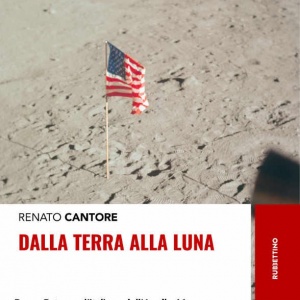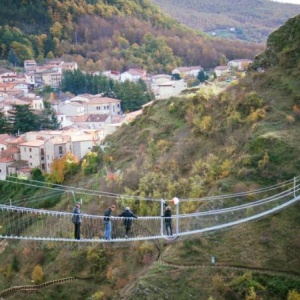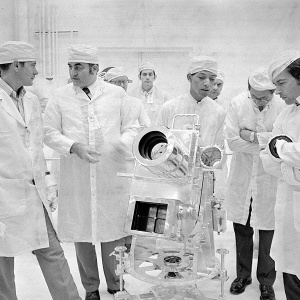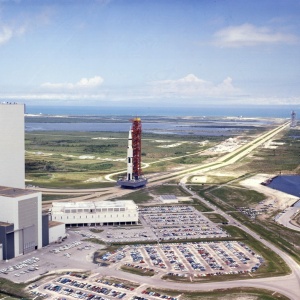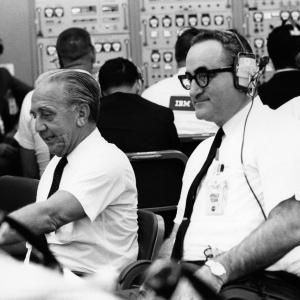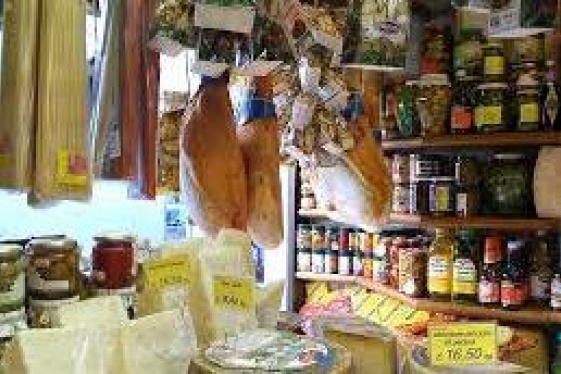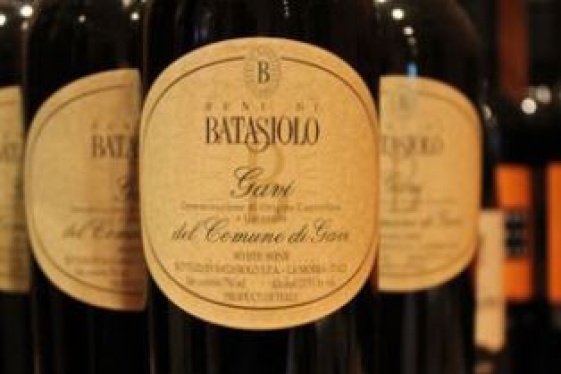
Renato Cantore (Author of the book "Dalla Terra alla Luna")
Scegliamo di andare sulla Luna: un piccolo passo per un uomo, un grande balzo per l'umanità, grazie a Rocco Petrone

On September 12, 1962, in Houston, in Texas, the State where he would be killed just over a year later, President John Fitzgerald Kennedy made a historic speech, in which he announced the race to the Moon. "We choose to go to the moon in this decade and do the other things, not because they are easy, but because they are hard," JFK said.
When you have to do something hard, you rely on the Italians. And so today, exactly 50 years after the first man on the Moon, we are happy to meet Renato Cantore, Italian journalist and friend of We the Italians, who wrote a beautiful book about Rocco Petrone, Director of the launch operations of Apollo 11, the man NASA relied on to do those "hard things" that unfortunately JFK didn’t get to see by himself
Renato, your book "Dalla Terra alla Luna" is a perfect path to follow to ask you to tell our readers the magnificent story of Rocco Petrone, a great Italian-American. So let's start from the beginning: can you tell us about Rocco's Italian origins? The moon was in his destiny... even before he was born.
Probably, yes. The moon was in his destiny because Sasso di Castalda, which is a small mountain village in the Basilicata (Lucania) region from which the Petrone family left in 1921, is a town that reaches almost a thousand meters high and in cloudless nights from there you can see the moon like nowhere else in Basilicata. It is an area extraordinarily free of light pollution and therefore the observation of the sky in this place is particularly impressive.
That area then linked even more to the Moon when in 2017 was inaugurated the “Ponte Alla Luna”, a Tibetan bridge almost 1,000 ft long and over 330 ft high that crosses what I would call almost a canyon, an ancient territory that contains geological finds of a very ancient land. It was called “Ponte Alla Luna” in homage to Rocco Petrone, because crossing this bridge seems almost a journey into the unknown, towards space, it is suspended between heaven and earth and then this bridge reminds a little bit the adventure of this boy of Italian origin.
Rocco was born in the United States, so the family had already moved from Italy…
Yes, the family left Sasso di Castalda in the winter of 1921, just a few months before the first Immigration Bill, when the United States began to close their borders: they arrived just in time. Rocco was born 5 years later, the third of three brothers, in 1926, in Amsterdam: a small industrial town in New York where his father had found a job in the railways and his mother in a glove factory. When Rocco was only 6 months old, in October 1926, his father Antonio died in a terrible accident in front of his house, overrun by a train that was maneuvering in front of his house, and then he left his wife and their three children, the oldest of whom was only 5 years old.
For a few months, the mother thought of returning to Italy, as it happened to many emigrants who met bad luck instead of finding the vein of gold. But then this brave woman decided that the children who were born Americans had to stay in America, rolled up her sleeves and - helped by the small Little Italy that already existed in Amsterdam - pulled up these boys, and there began the adventure of Rocco.
Rocco was always proud of his Italian roots, right?
Yes, he was always proud of his Italian origins. In those years many Italians changed their family names to hide this origin, but he was proud of these truly Italian name and family name. When Italian journalists arrived at Cape Canaveral to follow the lunar adventure, browsing the list of managers were very surprised by the fact that 80% of the names were German, the remaining 20% remembered roughly the Anglo-Saxon world, and then came out this name absolutely Italian. So they went to him, who with a few words in dialect explained that he was from Sasso di Castalda and that he had maintained a relationship with the village of his family, because every Christmas a greeting card from America would arrive to his relatives. Later he was also named commendatore by the President of the Republic.
Growing up, an important stage in his life is that of West Point...
Yes, here's another good chapter of this incredible story: how does a boy with an Italian name get to West Point in 1943, in the middle of the war? Let us remember that Italy was at war with the United States, and from West Point come out the officers of the American army.
Rocco arrived at West Point because in the years of high school in Amsterdam he was shining in an extraordinary way both in the school performance (he was the best of the school), both in athletic activities (he played both baseball and football).
His professors cared so much for him that they pointed him out to the MP from the Amsterdam area: to be admitted to the competition to enter West Point you needed a letter from a Member of the Parliament or a General who would guarantee the moral qualities of the candidate. His professors went to the congressman's office and said: "Look, there's this guy of extraordinary ability, he could win admission competitions to the most prestigious American colleges. But he is from a family of immigrants, he would never be able to pay the tuition, the only choice he has is to help him enter West Point, where he can become an officer and then his training would be paid by the army.”
And so Rocco, sponsored by this MP, made and passed the admission competition, went to West Point and began his career. Among other things, in the years of West Point he played in the football team as a defensive tackle: that was a legendary and very famous team, because for three years, exactly the years of Rocco's presence at West Point, they won the national football championship.
After the successes of West Point, this story sees another place of the American myth: Cape Canaveral. But how does one who grew up in a military academy and distinguished himself for playing football arrives at Cape Canaveral?
From West Point Rocco was sent to MIT to specialize in mechanical engineering. He arrived at Cape Canaveral because Eisenhower called von Braun (who had come over to the Americans and was involved in ballistic missiles) to ask him to help convert the military industry into the space industry and point the missiles at space instead of at some enemy on earth. Von Braun was a little hesitant, because he knew that the Soviets were well ahead in the space race. In order to convince him to accept the assignment and set up NASA, Eisenhower told him that he could choose anyone he wanted among the officers of the army, the air force, the navy. Then von Braun, who had met Rocco in Huntsville, Alabama, where he had just graduated and was sent there to do some practice in missile matters and launch rigs, said: "To begin with, give me Rocco Petrone who is bored in some Pentagon office and who instead we have to bring back to the field".
We have arrived at the crucial part of Rocco Petrone's life: he - with the nickname "the tiger" - will be the Director of the launch operations of Apollo 11, which brought the first man to the Moon.
It was a period that lasted 8 years: it all began in May 1961 with Kennedy's speech to the Congress, and ended with the sensational event of July 1969.
Rocco lived these years as a protagonist, because in reality he had arrived in Cape Canaveral in 1960 as the person in charge of the construction, design and assembly of the Saturn rocket. Saturn was the vector of Apollo: there was the Saturn rocket, the Apollo spacecraft and then the LEM, the module that landed on the Moon. The whole missile was about 360 ft high. The mission of all the different launches was called Apollo, but the astronauts used to call every different spacecraft in different ways: the one that left for the Apollo 11 mission was called Columbia, while the LEM was called Eagle.
After 1961, when Kennedy launched the race to the moon, Rocco was responsible for designing all the logistics for what he called the moon port, and also for choosing the point where to place the launch ramps for Saturn and create the great Assembly Building, where the rocket was assembled. Saturn was the first rocket that was not assembled horizontally, but vertically, piece by piece: six million pieces to put one on top of the other. Rocco was in charge of all this: from the construction of the rocket to all the controls, from the completion of the vehicle to the movement on the launch pad to the launch. In 1967 he was appointed Director of all launch operations at Cape Canaveral.
As you can imagine, Rocco was forced to be very strict in his work. They called him "the tiger", because his terrible rebukes to his collaborators and his checklists entered the myth: the only check-list of control operations on the lunar module, the LEM, consisted of a procedure of 30,000 control actions. He invented an expression: "Saturn five more minutes". When they asked him how long it would take for a specific operation, which would normally last 10 minutes, in Saturn's case it would have to last 15 minutes: because the philosophy was always "check & double check", if there was no double check, the next operation would not be carried out. In short, from the moment when the first pieces arrived (from all over the United States) at Cape Canaveral to the moment when the rocket was ready to leave, 5 months passed, when Rocco never ceased to check and recheck every single operation.
What happened to Rocco after the success of Apollo 11?
Three months after the success of Apollo 11 Rocco returned to Washington to NASA headquarters as Director of the entire Apollo program, and then followed all other missions until Apollo 17, when NASA decided to end the program, against his advice. He was convinced that there was still much to be done to understand the Moon: he was convinced that the Moon could be the new Stele of Rosetta, and that with the study of ancient lunar materials, they could discover much about the origin of the universe. But, in his opinion, since the Moon is not all the same, they should have explored it piece by piece, and would have needed many other missions, also developing the path that could make the Rover, the four-wheeled vehicle that was used in the last two missions. So he was very upset when the program was finished. He was sent to Huntsville to take over from von Braun, where he was the first nonGerman to lead the Marshall Space Flight Center, which was, let's say, the heart of the space adventure. In Alabama, however, he stayed only a year because he realized that, even there, those were times when people were fired and budgets were reduced. He returned to Washington again as an Associate Administrator of NASA and then moved to the private sector, working for a company that was in the field of energy production from waste recycling. Finally he was called by the Shuttle manufacturer and moved to California as head of the design of the space shuttle.
When he retired at the end of the 1980s, he dedicated himself to his true passion, which, incredibly for a mechanical engineer, was the study of history, especially the history of the American Civil War. Rocco loved history because he said it would help us understand the complexity of human affairs: because there will never be an algorithm to explain why people move in a certain way, or the sequence we went through in a few thousand years from caveman to the man on the Moon. According to him, this could only be understood through the complexity of history, which gives many points of view being never the same, and stimulates our intelligence much more than numbers and technologies do.
During an interview with BBC, they asked him, "After the Moon, what’s next?" He replied: "After the Moon there's no limit to human capabilities, if we decide to go to Mars we'll go to Mars, if we have to explore the galaxies we'll explore the galaxies, the only thing we need is a leader who knows how to dream and above all pull out a lot of money, the rest is just a matter of time.
Is there an anecdote you discovered while researching for your book, a curiosity you want to share with our readers?
There are two things: one describes a bit the climate of the time, of what those years were for the American society; the other describes precisely the key role of Rocco Petrone.
This is the first one. I asked his eldest daughter, Teresa, “How did you children experience so closely this great adventure that will remain in the history of man?” She replied: “I don't have a special memory because it was absolutely normal for us. We lived in these cities that were born in space centers, so for us it was absolutely normal that that was the activity: each of us had a playmate whose dad was an astronaut, or a space engineer or a rocket cleaner. They all took care of that: so, for us children, it was absolutely normal that the only activity of man was to go to the Moon.” So there are many children who have had a childhood all linked to this extraordinary adventure, and it is something that I believe has rarely happened in the history of human communities, because we are talking about a project that has involved about 500,000 people and their families, throughout America. An extraordinary popular adventure.
The second anecdote tells of a gift from Rocco: he had an exceptional photographic memory, he remembered every detail: I would say that he called by name all the six million pieces of Saturn! On July 16, 1969, when the countdown to the departure of the great adventure was in progress, at 5 in the morning he had detached for a moment and was in the cafeteria eating two eggs. He was joined by a boy who told him to go back to the control room because there was great excitement. The monitors showed a leak of liquid hydrogen on the second stage, a condition for which the crew could not board because it was very dangerous: hydrogen can cause a fire just by looking at it, which is enough to start a spark.
Rocco looked at the monitor and understood exactly where they had to go and indicated, in this huge 360-ft rocket, a valve with six bolts, one of which, instead of being one and three quarters inches long, was two inches long, that probably a technician thought of tightening anyway. This extra quarter inch had created this imperfect seal and therefore this loss, and if Petrone had not had the ability and readiness to resolve it in half an hour, he would have had to interrupt the mission, with the planetary debacle that we can imagine. He then described it this way: "For a damn quarter of an inch we were losing a mission that had to travel 250,000 miles and bring the man to the Moon.
By the way, if I'm not mistaken, it was a similar problem to one of the previous Apollo that led to the accident in which three astronauts died...
It was Apollo 1, and the accident did not occur at launch, it was just a simulation, and they died during the ground test.
That was the first test after Petrone's promotion to Director of all launch operations. We can well imagine how Rocco lived this drama: from then began his reputation as a tough, "tiger", because from that moment he reviewed all the procedures and imposed dozens and dozens of changes to the design of the ship and from there was born the "check & double-check", the extra 5 minutes for each operation.
Is there something typically and unequivocally Italian that contributed to the success of Rocco Petrone's life?
In a way we have already answered this question: this meticulousness and ability to work hard, which characterizes the Italians, is not only typically Italian, but of southern Italy and if you will allow me, even “Lucanian”. There is a beautiful expression of Leonardo Sinisgalli who says that the Lucanian is taken by the demon of dissatisfaction: he never feels satisfied with the result achieved, always seeks improvement, always seeks a step forward. In my opinion, this thing describes exactly the mentality of Rocco Petrone, who also had a beautiful and unequivocal face of a Lucanian peasant. This meticulousness, this precision, this search for excellence at the cost of doing 18 hours of work without stopping, makes him very southern Italian: with this story of suffering, of social redemption, which he carried with him; with this American dream that he realized in the most sensational way. Because, more than sending a man to the Moon, I don't know what else one could do.
You may be interested
-
'Phantom Limb': A Conversation With Dennis...
Dennis Palumbo is a thriller writer and psychotherapist in private practice. He's the auth...
-
‘Fuggedaboudit’ the motto of new Italian del...
By Kimberly Sutton Love is what brought Tony Nicoletta to Texas from New York.The transpl...
-
“The Hill” St. Louis’ Little Italy
When the fire hydrants begin to look like Italian flags with green, red and white stripes,...
-
2015 Bocce Bash!!
Please join Mia Maria Order Sons of Italy in America Lodge #2813 as we host the 2015...
-
An Unlikely Union: The love-hate story of Ne...
Award-winning author and Brooklynite Paul Moses is back with a historic yet dazzling sto...
-
Buon Appetito! Unique Italian dining at Ragú...
There's something to be said for having your food prepared tableside. Guacamole tastes fre...
-
Cathedral of St. John the Divine, Oratorio S...
For the first time ever, The Cathedral of St. John the Divine, in collaboration with the O...
-
Chef Carmelo Mauro to host Beni Batasiolo Wi...
Fiorenzo Dogliani, owner of Beni di Batasiolo, will join Carmelo Mauro for an exclusive wi...





